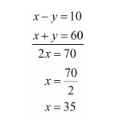Places A and B are 80 km apart from each other on a highway. A car starts from A and other from B at the same time. If they move in the same direction, they meet in 8 hours and if they move in opposite directions, they meet in 1 hour and 20 minutes. Find the speeds of the cars.
Let x and y be two cars starting from points A and B respectively.
Let the speed of the car X be x km/hr and that of the car Y be y km/hr.
Case I: When two cars move in the same directions:
Suppose two cars meet at point Q, then,
Distance travelled by car X = AQ
Distance travelled by car Y = BQ
It is given that two cars meet in 8 hours.
Distance travelled by car $X$ in 8 hours $=8 x \mathrm{~km}$
$A Q=8 x$
Distance travelled by car $Y$ in 8 hours $=8 y \mathrm{~km}$
$\mathrm{BQ}=8 y$
Clearly $A Q-B Q=A B$
$8 x-8 y=80$
Both sides divided by 8, we get
$x-y=10 \cdots(i)$
Case II: When two cars move in opposite direction
Suppose two cars meet at point P, then,
Distance travelled by X car X=AP
Distance travelled by Y car Y=BP
In this case, two cars meet in 1 hour 20 minutes, we can write it as 1 hour $\frac{20}{60}$ or
$1 \frac{1}{3}$ hours that is $\frac{4}{3}$ hours.
Therefore,
Distance travelled by car $y$ in $\frac{4}{3}$ hours $=\frac{4}{3} x \mathrm{~km}$
Distance travelled by car $y$ in $\frac{4}{3}$ hours $=\frac{4}{3} y \mathrm{~km}$
$A P+B P=A B$
$\frac{4}{3} x+\frac{4}{3} y=80$
$\frac{4}{3}(x+y)=80$
$(x+y)=80 \times \frac{3}{4}$
$x+y=60$....(ii)
By solving (i) and (ii) we get,

By substituting $x=35$ in equation (ii), we get
$x+y=60$
$35+y=60$
$y=60-35$
$y=25$
Hence, speed of car $X$ is $35 \mathrm{~km} / \mathrm{hr}$, speed of car $Y$ is $25 \mathrm{~km} / / \mathrm{hr}$.
Click here to get exam-ready with eSaral
For making your preparation journey smoother of JEE, NEET and Class 8 to 10, grab our app now.
